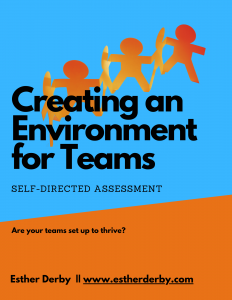Hiring new people for a team should always be a joint decision that involves team members. After all, who has more at stake than the people who will work with the new person day in and day out?
Consider what happened when a well-intentioned manager decided to hire without involving the team. His rationale was the team had fallen into group-think and needed “new blood” to shake them up. When I visited, I found a fractured team. The new member struggled for credibility. Half the team wouldn’t speak to him. The other half of the team spoke to him–and resented their former teammates for ostracizing him. The team wasn’t stuck in group-think any more, but they were too busy bickering to get much done.
Whatever the issue–workload, projects that require specific technical or domain skills–involve the team in the hiring process. You’ll increase the chance of a good fit and gain commitment to help the new hire succeed. Plus, sharing power with the team helps create partnership.
Describing the Ideal Candidate
Teams often have a good idea about what’s missing on the team and where the bottlenecks are. They know when they no longer have the capacity to keep up with an increasing workload. Look at the current work, and the near-future work. Examine the current skills and work approach. Then, work through a job analysis (see an example here).
Developing the Question Set
Involve the team in generating a list of questions that will reveal the candidates’ qualifications. Questions should focus on the skills, qualities and characteristics from the job analysis. Once you have a list, arrange the questions in logical groupings and prioritize them based on elimination factors along with required and desirable elements from the job analysis.
Finding Candidates
Team members may know others who are likely candidates. Activate those social networks! But don’t rely on the team to fill the funnel and sieve the candidates. Enlist HR to recruit and screen. Winnow down the likely candidates through phone screens. Bring the team back into the process when you have a handful of suitable candidates.
Interviewing
Assign one team member to each question area to avoid subjecting the candidate to the same questions over and over, and ensure all areas are covered. If the team members are sufficiently skilled, have them do one-on-one interviews. Or have a lead interviewer present in all interviews and assign a different team member present for each interview segment. The team member can ask the bulk of the questions, but the lead interviewer is there to listen for areas to probe for more information. This is a good option if the team hasn’t been involved in interviewing before.
In the United States, some questions are illegal, while some are okay if you ask everyone the same question. I don’t expect team members to know these rules. Invite your HR representative to brief the team on what’s appropriate and what is not.
You may want to do some practice interviews so team members know what to listen for, how to probe for deeper insights and recognize red flags.
Auditioning
Auditions provide a candidate with the chance to demonstrate relevant skills. Unlike solving puzzles, these auditions relate directly to the work the candidate would perform. For example, you might ask a person to write a small function in a language he claims to know. Or, have the candidate test your product (after you’ve given him enough background information so he’s not completely lost). You can ask a designer to review an existing design and add some new feature. No matter what the job, you can devise a way for the candidate to show his stuff.
Pairing
Some companies seem to think that as long as a candidate can solve cognitive puzzles and answer technical questions, they’re good to go. Technical skills are a necessity, but not sufficient to succeed in most organizations. This is especially true when team-based work or communication with other humans is involved.
Pairing–whether to program, test or design–gives a window into technical skills and much more. More and more companies are bringing in top candidates to pair for a half or full day. You will need an NDA (nondisclosure agreement), and possibly need to cover some expenses for the candidate who is probably using a vacation day to participate. But at the end, you’ll know much more about how the candidate responds to new situations, and how he approaches problems. You’ll know how something about how he enters groups, and his ability to interact with people on the team. You’ll know whether the candidate is confident enough to ask questions, admit when he doesn’t know something and is willing to learn from others. You will avoid hiring someone who will rub everyone on the team the wrong way.
So you’ve involved team members in various ways. Now what? It depends on how much you want the team to invest in the new hire’s success.
Choosing
From a legal perspective, an agent of the company must make the salary offer and complete the legal aspects of hiring. But choosing a candidate is a shared responsibility. Bring the hiring team together and pool the information. Check for elimination factors and see who you are left with. If there is only one remaining candidate, your work is still not done.
Create a gradient of agreement to gage the level of support for the candidate. When there is only lukewarm support, keep looking. If the results are at the extremes, explore the reasons for both strong support and opposition. In some cases, hearing another point of view will change some minds. But if not, move on. If you hire someone abhorrent to one member of the team, you’ll have problems in the long run. (When someone is opposed to every candidate and has no credible reason, you’ve got a different problem.) Strive for consensus–you want the team to support the person, not tolerate him or her. Over-rule the team at your peril–because if you do, you will own every problem with the new hire.
It’s an Investment
Preparing team members to participate in the hiring process will take time–time to coach the team on which questions to ask and which ones to avoid; time to teach the team what to listen for; and time for practice interviews. Is it worth it? Yes! Interviewing is a broadly applicable skill. The abilities to formulate questions and to listen for what is said and unsaid are invaluable in speaking with customers, clarifying problems and devising solutions.
The person who makes the hiring decision has a vested interest in having that person work out. Including the team in the hiring process ensures that the manager is not the most invested party. Because the team chose the new candidate, they will be more willing to show the new person the ropes and explain the context and domain. They’ll be more likely to offer help and encouragement. By having the whole team involved, you’ve created a support group to aid the new person with integrating into the group and become a productive member of the team.
Most importantly, involving more people in the hiring decision shares power and creates partnership. And if you want to get the best out of people, that’s what you want to be–partners.
Resources
If you want to learn about hiring–soup to nuts–get yourself a copy of Hiring the Best Knowledge Workers, Techies & Nerds by Johanna Rothman.
This article originally appeared on Gantthead.com.




Yes!
Happily, in alignment with Team Tips – 3 as well.
Thanks Esther.
Cheers, Paul
Hiring of a competitive candidate worth investments
Don’t forget to throw a “control subject” candidate into the hiring process.
Worth the investment of time – If you can’t do anything else.